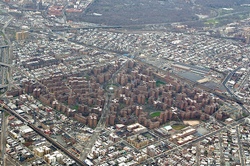 Parkchester is a residential neighborhood geographically located in the south central Bronx, New York City. The neighborhood is part of Bronx Community Board 9. Its boundaries, starting from the north and moving clockwise are: East Tremont Avenue to the north, Castle Hill Avenue to the east, the Cross-Bronx Expressway-Westchester Avenue to the south (Westchester Avenue is the southern border east of Metropolitan Avenue), and the Bronx River Parkway to the west. White Plains Road is the primary thoroughfare through Parkchester. The local subway is the 6 line, operating along Westchester Avenue. ZIP codes include 10460 and 10462. The area is patrolled by the 43rd Precinct located at 900 Fteley Avenue in Soundview. New York City Housing Authority (NYCHA) property in the area is patrolled by PSA 8 at 2794 Randall Avenue in Throgs Neck.
Parkchester is a residential neighborhood geographically located in the south central Bronx, New York City. The neighborhood is part of Bronx Community Board 9. Its boundaries, starting from the north and moving clockwise are: East Tremont Avenue to the north, Castle Hill Avenue to the east, the Cross-Bronx Expressway-Westchester Avenue to the south (Westchester Avenue is the southern border east of Metropolitan Avenue), and the Bronx River Parkway to the west. White Plains Road is the primary thoroughfare through Parkchester. The local subway is the 6 line, operating along Westchester Avenue. ZIP codes include 10460 and 10462. The area is patrolled by the 43rd Precinct located at 900 Fteley Avenue in Soundview. New York City Housing Authority (NYCHA) property in the area is patrolled by PSA 8 at 2794 Randall Avenue in Throgs Neck.
The housing development has the same origins as Stuyvesant Town, Peter Cooper Village and Riverton Houses in Manhattan, all of which were originally developed and owned by the Metropolitan Life Insurance Company. The name was later applied to the entire neighborhood surrounding the apartment complex. The name “Parkchester” itself was derived from the two neighborhoods on each side of the site of the housing development – Park Versailles and Westchester Heights – both of which have not been in common usage since, and have been replaced by Parkchester as a means of referring to the entire area.[citation needed]
Metropolitan Life displayed an intricate scale model of the proposed development at the 1939 New York World’s Fair. The model showed all of the buildings and facilities, and was accurate down to inclusion of each of the 66,000 windows in the complex. The 51 groups of buildings were planned to house 12,000 families.
The Parkchester housing development was originally designed and operated as a self-contained rental community for middle-class families new to home ownership. To that end, there is an abundance of worker- and family-oriented resources, including access to transportation, nearby schools and churches, retail shopping space, and proximity to a major medical center.
It was built from 1939-42 (despite emergency building restrictions during World War II) on the farmland of the Catholic Protectory, a home for orphaned and troubled boys, which relocated to (and still exists in) upstate New York. In 1974, approximately one-third of the complex was converted to condominiums, with the remaining portion, now Parkchester South Condominium converted later, in 1986. The complex is best known for its broad, tree-lined walkways between the distinctive red-brown buildings, and for its Works Progress Administration-style terracotta decorations on the buildings, that represent animal and human figures of many types. Many of these are the work of sculptor Joseph Kiselewski.
It was a welcome affordable haven for returning WWII vets and their burgeoning families in the early 1940s. While racially segregated, it peacefully housed people from all religious backgrounds.
As of 2007, the Parkchester apartment complex includes a very large, thriving, well-established South Asian population: Pakistani, Bangladeshi, Indian, including Catholics, Muslims, and Hindus. There are also a number of Italian, Polish, Irish, and Albanian residents. The Asian residents include Thais, Chinese, Japanese, Vietnamese, Filipinos, Burmese, and Cambodians. While the population is approximately over 20% African American and Latino, the complex once had a whites-only policy. The resident population of the Parkchester apartment complex reflects a broad age distribution and the changing ethnic makeup of the Bronx over nearly 70 years of history.
The surrounding Parkchester neighborhood is majority Hispanic and Black. Puerto Ricans are the dominant ethnic group. The area is low income and has a high poverty rate of over 30%.
Due to White flight some of the homes in the area have been left vacant. Many homes today are being rehabilitated and offered as rentals to the growing low income population found in the area. The Parkchester Apartment complex has also received major renovations over the past few years.
